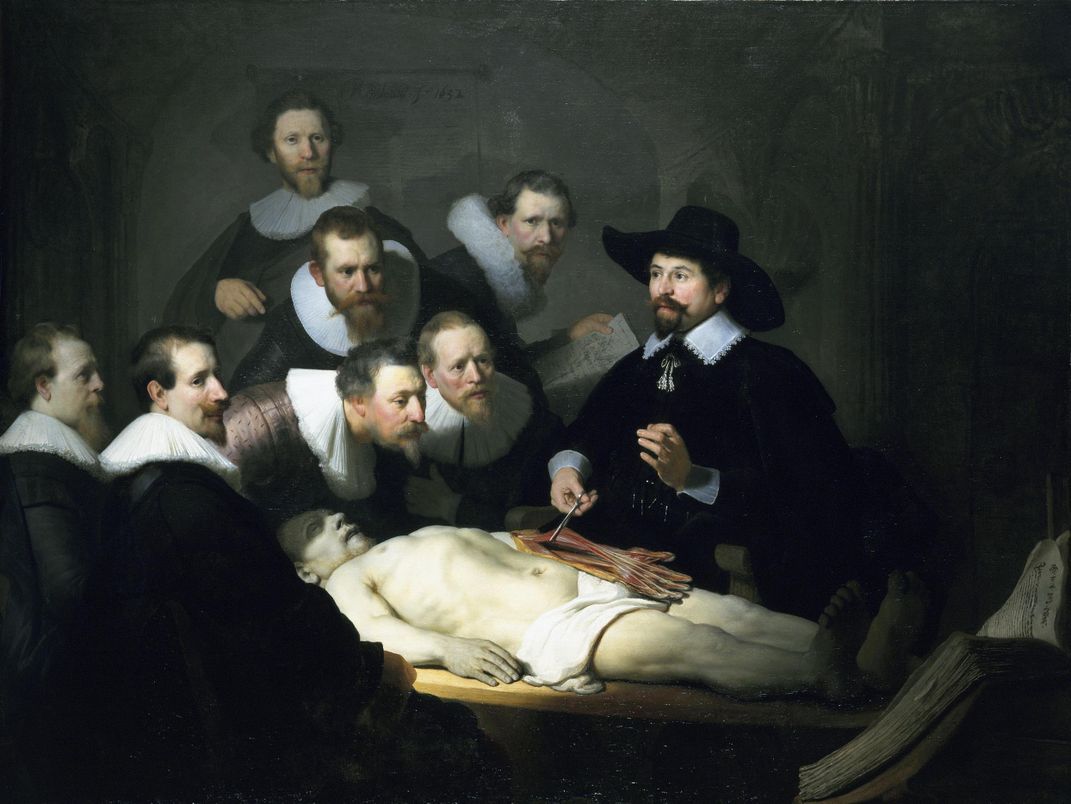A Sixteenth-Century Hot Date Might Include a Trip to the Dissecting Theater
Anatomy theaters were an early site for science as spectacle
/https://tf-cmsv2-smithsonianmag-media.s3.amazonaws.com/filer/6d/a7/6da74714-5cb8-4a0f-8b7f-f9f8fe219beb/guillaume-rondelet-1507-1566.jpg)
Picture it: A rapt audience, serenaded by a group of musicians, leans forward to see the performance. Only the actors are doctors and the scenery is a corpse.
Today is the 510th birthday of Guillame Rondelet, the man who founded one of Europe’s most important dissecting theaters. His theater in Montpellier, France, was part of France’s oldest medical school, where the cutting-edge science of anatomy was practiced for public consumption. Rondelet and his contemporaries hoped that anatomy would lead to new knowledge which would help create a better, healthier world.
The practice of publicly viewing dissections stretches as far back as 1493, according to historian William Brockbank writing in the journal Medical History. Then, an Italian physician named Alexander Benedetti wrote that “there must be guards to restrain the eager public as it enters,” and two people should stand at the door to take entry fees. “The outstanding personalities and authorities of the town were invited to be present.”
Renaissance anatomical dissections had a number of theatrical elements, according to historian Giovanna Ferrari writing for the journal Past & Present: beyond the fact that the places where they were held were called dissecting theaters, spectators had to buy a ticket to enter. Inside, they could expect to hear a musical performance while watching the show, a dissection that had been carefully choreographed and included a number of different roles, from dissector to assistants, who Benedetti wrote “must not mind horrors or faint in the presence of a corpse.”

In France, where Rondelet lived, public attendance at dissections really took off after 1537. The “huge crowds” led to the establishment of permanent anatomical theaters where dissections could take place, writes Sanjib Kumar Ghosh in the journal Anatomical Cell Biology. Rondelet established his permanent anatomical theater at the university in Montpellier in 1556.
The links between these grisly theaters and modern medicine are fairly obvious: after all, an operating room is still sometimes called an “operating theater” and medical students still perform dissections for the purposes of learning about anatomy. But Ferrari also explains how anatomy theaters were related to modern theaters.
“Like actors, all those who worked on stage...–the medical theorist and the dissectors–had to show their faces to an audience and clearly display the actions they performed,” she writes. And while early anatomy theaters conducted their performance in the middle of a circle of onlookers (“in the round” as today’s theater buffs may know it), it was anatomy theaters that produced the semi-circular audience layouts common to theaters today.
“The anatomical theater buildings existing before the playhouses, namely in Montpellier, give evidence to the fact that experimental anatomy had become a cultural institution,” writes Ferrari.
One of the attractions to watching an anatomy performance may have been the relative rarity of such performances. In Montpellier,write a group of clinicians for the journal Clinical Anatomy, Rondelet lamented the difficulty of finding corpses to use for his dissections. “Although it was legal, there was significant prejudice and stereotyping surrounding the use of human cadavers for dissection,” they write. “When his own infant son died, Rondelet saw this as a teaching opportunity and publicly dissected him in the new amphitheatre to determine the cause of death.”
This might sound horrifying to modern ears, but think about the world this was happening in: Death surrounded Renaissance Europeans. Between the bubonic plague that was still sporadically sweeping the continent and the myriad other diseases running rampant in quickly growing cities, it was common for people, especially children, to die.
In these circumstances, the understanding that anatomy–however theatrically conducted–promised to Rondelet and his contemporaries must have been compelling. “Rondelet had hoped that the knowledge gained from this dissection would help others, they write.” In a letter written to his student Michel Nostradamus (yes, that Nostradamus) after the dissection, he expressed his enthusiasm for the idea that anatomy might offer a way forward for medical science. “Mark you, we do not know any more yet than our ancestors, but thanks to Aristotle, we are learning how to go after knowledge, how to observe and study facts–that is what will carry medicine forward.”